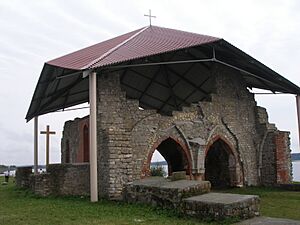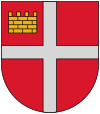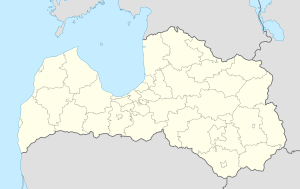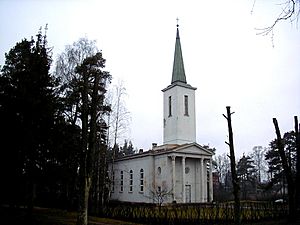Ikšķile facts for kids
Quick facts for kids
Ikšķile
|
|||
|---|---|---|---|
|
Town
|
|||
 |
|||
|
|||
| Country | |||
| Municipality | Ogre Municipality | ||
| Town rights | 1992 | ||
| Area | |||
| • Total | Lua error in Module:Wd at line 1,575: attempt to index field 'wikibase' (a nil value). km2 (Formatting error: invalid input when rounding sq mi) | ||
| • Land | Lua error in Module:Wd at line 1,575: attempt to index field 'wikibase' (a nil value). km2 (Formatting error: invalid input when rounding sq mi) | ||
| • Water | Expression error: Unexpected < operator. km2 (Formatting error: invalid input when rounding sq mi) | ||
| Elevation | 20 m (70 ft) | ||
| Population | |||
| • Total | Lua error in Module:Wd at line 1,575: attempt to index field 'wikibase' (a nil value). | ||
| Time zone | UTC+2 (EET) | ||
| • Summer (DST) | UTC+3 (EEST) | ||
| Postal code |
LV-5052
|
||
| Calling code | +371 650 | ||
| Number of city council members | 15 | ||
Ikšķile is a town in Latvia, located in Ogre Municipality. It's a very old and important place. Long ago, it was the first capital of a special church area called the Roman Catholic Bishopric of Livonia. This area was also known by its German name, Üxküll.
The first bishop of Üxküll was Saint Meinhard. Later, another bishop named Berthold of Hanover took over. Back then, Ikšķile was a busy center for crusading activities in the Livonian area. Bishop Berthold later moved the church's main office to Riga.
The name Ikšķile might come from the Livonian language. One idea is that "Ikšķile" meant "the place where you could cross the Daugava River". This spot belonged to the son of a powerful local leader named Ike. The Ike family was very strong in Livonia. They controlled trade and military travel across the Daugava.
Another idea is that the name comes from Livonian words meaning "one village".
Contents
A Look Back: Ikšķile's History
Ikšķile is one of the oldest places where people have lived in Latvia. We know this from old burial grounds and a mound found in the area. By the 9th to 12th centuries, a Liv village already existed here. It was located on the Daugava River, which was an important waterway for trade.
Latvia's First Castle
Building castles was a big deal in early Latvia. We learn about this from the Livonian Chronicle of Henry. This book was written by Henry of Livonia, who saw these events happen. He wrote about a monk named Meinhard. Meinhard heard stories about the Daugava River, where pagan tribes like the Livs and Letts traded.
Meinhard decided to go there to teach people about Christianity. After some people converted, he built a church in Ikšķile. But the church was not safe from attacks, especially from Lithuanian pagan groups. One winter, after an attack, Meinhard and the local people hid in the forests. Meinhard told the Livonians they were foolish for not having strong defenses. He promised to build castles if they became Christians.
In 1185, skilled stonemasons from Gotland built the castle of Ikšķile. They also built a chapel or church inside it. This was the first stone castle ever built in Latvia. It was also the oldest stone building in the whole Eastern Baltic region.
In 1186, a high-ranking bishop from Bremen made Meinhard the first bishop of Ikšķile. Under his leadership, Ikšķile became the main place for Catholicism to spread in Latvia. Both Meinhard and the second bishop, Berthold, were buried inside the Ikšķile Church. (Bishop Meinhard was later moved to the Riga Cathedral in Riga). After Berthold, Albert of Buxhovden became bishop. He came to his new area with a large army of crusaders. He had support from the Holy Roman Emperor and the Pope.
Moving the Bishopric Center
Bishop Albert soon realized that Ikšķile was too far from the sea to be effective in battles. So, he asked for another fortress closer to the coast. This led to the founding of Riga. In 1201, Bishop Albert moved the main church office from Ikšķile to Riga.
During the Livonian Crusade, Ikšķile Castle was attacked many times. Troops from Semigallia attacked it. Also, in 1203 and 1206, Prince Vladimir of Polotsk tried to capture the castle.
The Ikšķile castle was destroyed in the 17th century. The church, which had been rebuilt many times, was destroyed in 1916 by German artillery during World War I. In 1933, a new Lutheran church was built near Ikšķile.
In the 1970s, the Riga Hydroelectric Power Plant was built. This created a large reservoir, and the ruins of the first stone church ended up on an island. This island was made bigger and stronger to protect the ruins. The ruins of Ikšķile manor and the castle are now under the water of the reservoir.
Ikšķile School Life
Ikšķile Secondary School is a public school in Latvia. It was founded in 1966. It is also part of a program called Junior Achievement Latvia.
The first school in Ikšķile started way back in 1864. It was a parish school. About a hundred years later, people decided to build a new school. This new building was near the center of Ikšķile, next to the new A6 highway. The Ikšķile School opened in 1966. As the town grew, more schools were built. This allowed it to become a secondary school. From 1989 to 1990, the school was rebuilt again. In 1990, it was officially named Ikšķile Secondary School.
Ikšķile Library
The Ikšķile District Central Library is the main library in Ikšķile. It is located on Peldu street 22.
The first library in the Ikšķile area started in the early 1800s. The earliest written record about a library here is from 1852. It mentions a "Reading Association" with 35 members in the Ikšķile area. The library was reopened in 1946, after the Second World War. Over the years, the library changed. In 1974, a separate children's library was created.
Cool Places to See in Ikšķile
- Ruins of the Ikšķile Church - These are the remains of the oldest stone building in Latvia. They are on a small island called Sv. Meinard Island. This island was made by people when the Riga hydroelectric power station reservoir was built. The original Ikšķile Church was built in 1185. It was rebuilt several times but destroyed in 1916. When the reservoir was flooded in the 1970s, the ruins became surrounded by water. Today, the ruins are protected with a roof, and the island is secure. Once a year, when the water level is low, you can walk to the ruins along an old road.
- Ikšķile Lutheran Church - This church is located at Kalēju street 1. It was built between 1931 and 1933 by architect Kundziņš. During the Soviet era, the church was used as a bookstore.
- Memorial Stone - This stone is opposite the old church ruins. It has the name "Ikšķile" written in Latvian, Liv, and German. It was put there in 1988.
- Ikšķile Spiritual Orthodox Church - This Orthodox church was built in 1936. It has Orthodox graves nearby.
- Artist J. Kuga's Dwelling House - This house at J.Kugas street 11 was home to a famous Latvian artist and stage designer, Janis Kuga (1868–1969). He is known as the founder of stage painting in Latvia. The house is an important architectural site, and there are plans to turn it into a museum.
- Ikšķile Lutheran Cemetery - This cemetery is on Klusajā street. It has a monument from 1926 for Latvian riflemen who died in World War I. There are also two gravestones that are considered national art monuments.
- Kapāmuru Brothers' Cemetery - This is where Russian and German soldiers who died in World War I are buried. A monument was made here in 1968 by sculptor J. Karlova.
- Liepāderu Brothers' Cemetery - Soldiers who died in the Jugla battle of 1917 are buried here.
- Turbu Grandstand - This is a very large tree with a trunk that is over 7.1 meters around!
- Relziķu Oak - Another impressive tree, this oak has a trunk circumference of 5.3 meters.
- Kranciema Juniper - A juniper tree with a trunk circumference of 1 meter.
- Ikšķiles Open Air Stage - This is a historical and cultural place. It was given monument status in 2008.
See also
 In Spanish: Ikšķile para niños
In Spanish: Ikšķile para niños





